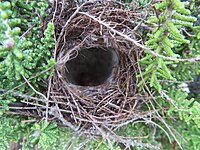Orange-breasted sunbird
| Orange-breasted sunbird | |
|---|---|

| |
| Male bird on a protea flower | |
| Scientific classification | |
| Domain: | Eukaryota |
| Kingdom: | Animalia |
| Phylum: | Chordata |
| Class: | Aves |
| Order: | Passeriformes |
| Family: | Nectariniidae |
| Genus: | Anthobaphes Cabanis, 1851 |
| Species: | A. violacea
|
| Binomial name | |
| Anthobaphes violacea (Linnaeus, 1766)
| |
| Synonyms | |
| |
The orange-breasted sunbird (Anthobaphes violacea) is a species of small, predominantly nectar-feeding bird that is
Taxonomy
In 1760 the French zoologist
Description
As with other sunbirds the bill is long and decurved, that of the male being longer than that of the female. The bill, legs and feet are black. The eyes are dark brown. The head, throat and mantle of the male are bright metallic green. The rest of the upper parts are olive green. The upper breast is metallic violet and the lower breast is bright orange, fading to paler orange and yellow on the belly. The tail is long and blackish, with elongated central tail feathers, which extend beyond the other feathers. The female has olive-greenish grey upperparts and olive yellowish underparts, paler on the belly. The wings and tail are blackish. The juvenile resembles the female.[7]
The call is a twangy, weak ssharaynk or sskrang, often repeated several times.[7]
Distribution and habitat
Due to its restricted range within the fynbos biome of South Africa's Western Cape, this sunbird is associated with ericas and proteas. It breeds when the heath flowers, typically in May. The male defends its territory aggressively, attacking and chasing intruders.
This tame species is a common breeder across its limited range, and is an altitudinal migrant, moving to higher altitudes during the southern summer in search of flowers. It is gregarious when not breeding, forming flocks of up to 100 birds.[7][8]
Behaviour
Breeding
The orange-breasted sunbird breeds from February to November (mainly in May–August). The nest, built mainly by the female, is an oval of rootlets, fine leafy twigs and grass, bound together with spider webs and lined with brown protea fluff. It has a side top entrance, but does not have a covered porch.[7][8] The usual clutch is two eggs and the female alone incubates. The eggs hatch in about 14.5 days and both parents feed the young. The young birds are mostly fed with insect and spider prey.[9]
-
Female collecting leaf hairs to line nest
-
Nest
Food and feeding
The orange-breasted sunbird subsists on flower nectar, predominantly from ericas and proteas, although it will make use of other types of flowering plants as well. It will also take small insects and spiders, often in flight.[8]
Ecology
Orange-breasted sunbirds are known to pollinate Protea, Leucospermum, and Erica species,[10][11] the flowers of which they visit for nectar.[12] They perch on the ground to visit the low flowers of Hyobanche sanguinea and Lachenalia luteola.[13] They also indulge in nectar theft from flowers with longer corolla tubes such as Chasmanthe floribunda.[14] Being fire-prone, the fynbos habitat ensures a great amount of mobility of the birds, which may have contributed to a greater level of individual genetic variability despite having a rather limited distribution range.[15]
A number of plasmodia-like blood parasites are known from the orange-breasted sunbirds.[16]
Conservation status
This species is currently classified as
References
- ^ . Retrieved 12 November 2021.
- ^ Brisson, Mathurin Jacques (1760). Ornithologie, ou, Méthode contenant la division des oiseaux en ordres, sections, genres, especes & leurs variétés (in French and Latin). Vol. 3. Paris: Jean-Baptiste Bauche. pp. 649–651, Plate 33 fig 6. The two stars (**) at the start of the section indicates that Brisson based his description on the examination of a specimen.
- ^ hdl:2246/678.
- ^ Linnaeus, Carl (1766). Systema naturae: per regna tria natura, secundum classes, ordines, genera, species, cum characteribus, differentiis, synonymis, locis (in Latin). Vol. 1, Part 1 (12th ed.). Holmiae (Stockholm): Laurentii Salvii. p. 188.
- ^ Cabanis, Jean; Heine, Ferdinand (1850). Museum Heineanum : Verzeichniss der ornithologischen Sammlung des Oberamtmann Ferdinand Heine, auf Gut St. Burchard vor Halberstadt (in German and Latin). Vol. 1. Halberstadt: R. Frantz. p. 103.
- ^ Jobling, J.A. (2018). del Hoyo, J.; Elliott, A.; Sargatal, J.; Christie, D.A.; de Juana, E. (eds.). "Key to Scientific Names in Ornithology". Handbook of the Birds of the World Alive. Lynx Edicions. Retrieved 2 April 2018.
- ^ a b c d Sinclair, Ian; Hockey, Phil; Tarboton, Warwick; Ryan, Peter (2011). Sasol Birds of Southern Africa: The Region's Most Comprehensively Illustrated Guide. Struik.
- ^ a b c "Orange-breasted sunbird - Species text in The Atlas of Southern African Birds" (PDF).
- ISSN 0030-6525.
- ISSN 0254-6299.
- S2CID 1245380.
- ISSN 1444-9862.
- ISSN 0254-6299.
- PMID 27219484.
- ISSN 2410-7220.
- PMID 25352083.



